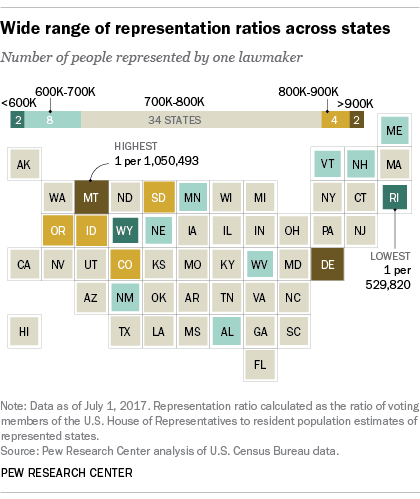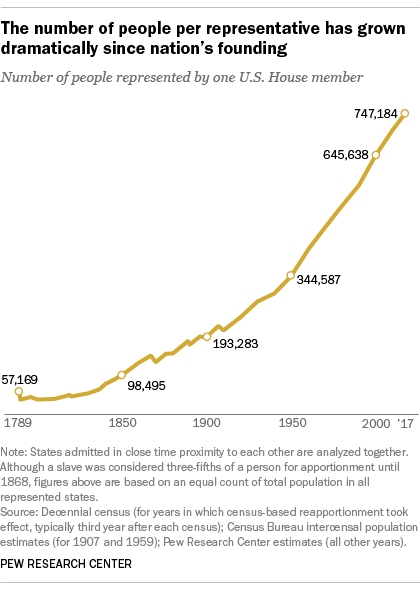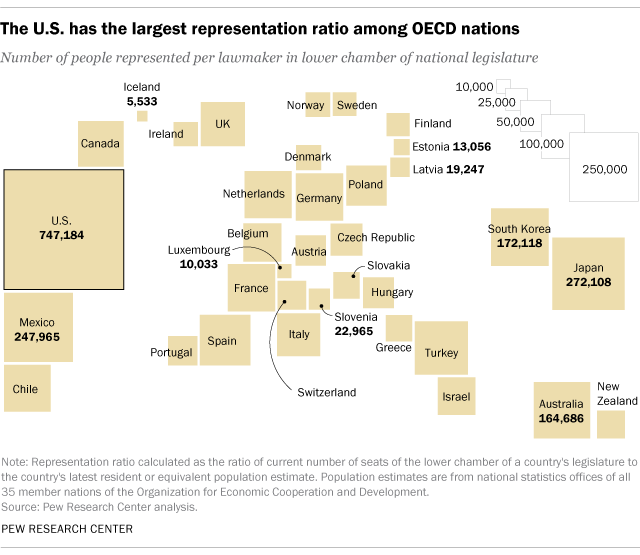How Many Members Are in the Texas House of Representatives
The U.S. House of Representatives has one voting member for every 747,000 or and then Americans. That's by far the highest population-to-representative ratio among a peer group of industrialized democracies, and the highest it's been in U.Due south. history. And with the size of the House capped by law and the country's population continually growing, the representation ratio likely volition only get bigger.
In the century-plus since the number of House seats offset reached its current total of 435 (excluding nonvoting delegates), the representation ratio has more tripled – from i representative for every 209,447 people in 1910 to one for every 747,184 as of concluding year.
 That ratio, mind you, is for the nation as a whole. The ratios for individual states vary considerably, mainly considering of the House's fixed size and the Constitution's requirement that each land, no matter its population, have at least one representative. Currently, Montana'south one,050,493 people have just one House member; Rhode Isle has slightly more people (i,059,639), but that's enough to give it two representatives – i for every 529,820 Rhode Islanders.
That ratio, mind you, is for the nation as a whole. The ratios for individual states vary considerably, mainly considering of the House's fixed size and the Constitution's requirement that each land, no matter its population, have at least one representative. Currently, Montana'south one,050,493 people have just one House member; Rhode Isle has slightly more people (i,059,639), but that's enough to give it two representatives – i for every 529,820 Rhode Islanders.
The U.S. findings in this mail are based on Pew Research Middle analyses of House membership changes since 1789 and historical population data (actual when available, estimated when non). They exclude territories, the District of Columbia and other U.S. possessions that don't take voting representation in the House. The analysis was complicated somewhat by the fact that new states often were admitted after a decennial census but before the circulation law based on that demography took effect (normally well-nigh three years afterward). In such cases, the new states were analyzed every bit if they had been states at the fourth dimension of the demography.
How the House reached 435
The first Congress (1789-91) had 65 House members, the number provided for in the Constitution until the first census could be held. Based on an estimated population for the 13 states of iii.vii one thousand thousand, there was ane representative for every 57,169 people. (At the fourth dimension, Kentucky was role of Virginia, Maine was part of Massachusetts, and Tennessee was part of North Carolina. Vermont governed itself as an independent republic, despite territorial claims by New York.)
By the time the first circulation bill took consequence in March 1793, Vermont and Kentucky already had joined the Spousal relationship; the 15 states had a total population of iii.89 meg. Since the apportionment police provided for 105 House members, there was one representative for every 37,081 people. (According to the Constitution at the time, only three-fifths of the nation'due south 694,280 slaves were counted for circulation purposes; using that method, the ratio was approximately one representative for every 34,436.)
For more than a century thereafter, as the U.Due south. population grew and new states were admitted, the House's membership grew too (except for two short-lived contractions in the mid-1800s). The expansion more often than not was managed in such a style that, even as the representation ratio steadily rose, states seldom lost seats from one apportionment to the next.

That process ran aground in the 1920s. The 1920 census revealed a "major and continuing shift" of the U.Due south. population from rural to urban areas; when the fourth dimension came to reapportion the House, every bit a Demography Bureau summary puts information technology, rural representatives "worked to derail the process, fearful of losing political power to the cities." In fact, the Firm wasn't reapportioned until later the 1930 census; the 1929 law authorizing that census also capped the size of the House at 435. And at that place it has remained, except for a brief menstruation from 1959 to 1963 when the bedchamber temporarily added 2 members to correspond the newly admitted states of Alaska and Hawaii.
There have been occasional proposals to add more seats to the House to reflect population growth. One is the so-called "Wyoming Dominion," which would make the population of the smallest country (currently Wyoming) the footing for the representation ratio. Depending on which variant of that rule were adopted, the House would have had 545 to 547 members following the 2010 census.
Yet, a recent Pew Research Center survey constitute limited public support for adding new House seats. Only 28% of Americans said the House should be expanded, versus 51% who said information technology should remain at 435 members. When historical context was added to the question, support for expansion rose a bit, to 34%, with the boosted support coming mainly from Democrats.
How the U.S. compares globally
The House'south hefty representation ratio makes the United States an outlier amidst its peers. Our enquiry finds that the U.S. ratio is the highest among the 35 nations in the Organization for Economic Cooperation and Evolution, almost of them highly developed, democratic states.
 We took the most recent population judge for each OECD nation and divided it by the current number of seats in the lower sleeping accommodation of each national legislature (or, in the case of unicameral bodies, the single chamber). After the U.Due south., the 2 countries with the highest representation ratios are Japan (one lawmaker for every 272,108 Japanese) and United mexican states (1 for every 247,965 Mexicans). Iceland had the everyman ratio: one member of the Althing for every v,500 or and so Icelanders.
We took the most recent population judge for each OECD nation and divided it by the current number of seats in the lower sleeping accommodation of each national legislature (or, in the case of unicameral bodies, the single chamber). After the U.Due south., the 2 countries with the highest representation ratios are Japan (one lawmaker for every 272,108 Japanese) and United mexican states (1 for every 247,965 Mexicans). Iceland had the everyman ratio: one member of the Althing for every v,500 or and so Icelanders.
While much of the cross-national disparity in representation ratios can be explained by the big population of the U.Southward. (with more than than 325 million people it'south the largest country in the OECD), that's not the simply reason. Eight OECD countries accept larger lower chambers than the U.S. Firm, with Germany's Bundestag topping the league tabular array with 709 members. The British House of Eatables has 650 MPs (Members of Parliament); Italian republic's Bedroom of Deputies has 630 lawmakers.
Even if Congress decided to expand the size of the Business firm, the large U.S. population puts some practical limits on how much the representation ratio could exist lowered. If the House were to grow as large as the Bundestag, for case, the ratio would fall only to 1 representative per 458,428 people. In order to reduce the ratio to where it was later on the 1930 demography, the House would need to take one,156 members. (That would still be smaller than China's National People'southward Congress, the largest national legislature in the earth with 2,980 members.)
Source: https://www.pewresearch.org/fact-tank/2018/05/31/u-s-population-keeps-growing-but-house-of-representatives-is-same-size-as-in-taft-era/
0 Response to "How Many Members Are in the Texas House of Representatives"
Enregistrer un commentaire